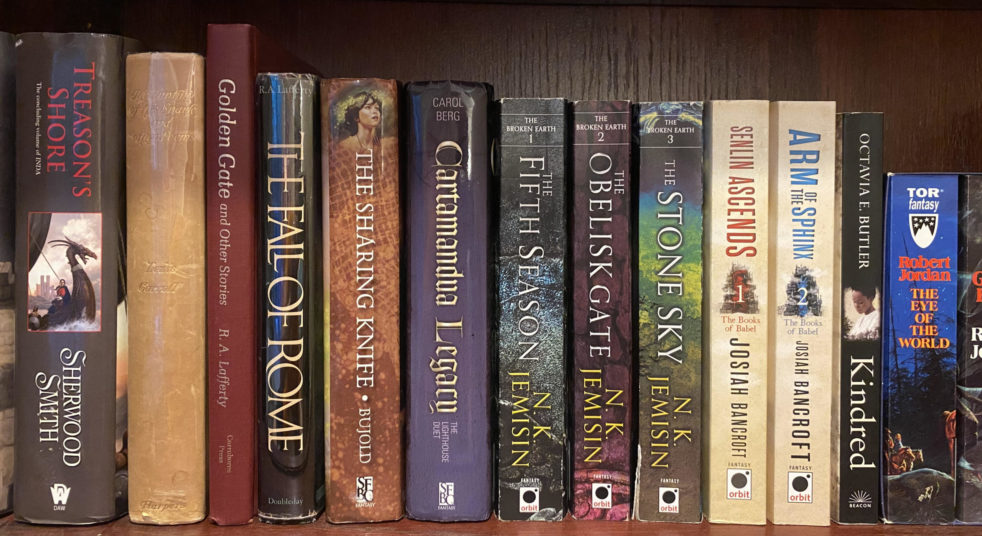I’m wrapping up my first year of regular magazine reading with a short review of the December 2023 issues of Clarkesworld and GigaNotoSaurus. Both publications were well worth reading all year, and this month is no exception. Stay tuned for a deep dive into my favorite stories of the year—hopefully to be posted this week—and some reflections on magazine reading and finding short fiction more generally, probably out in January. But for now, let’s dive into this month’s work:
Clarkesworld
I didn’t think December’s issue of Clarkesworld had one story that stood head-and-shoulders above the rest, but it was shockingly consistent in quality. Clarkesworld has been my favorite magazine this year, but even so, when I look back at my (idiosyncratic, 20-point) ratings spreadsheet, I regularly see a 13 or two (“did some good things, didn’t totally click”) along with a 17 or two (“probably not my favorite of the year, but definitely on the monthly favorites list”). This month, I’d marked down nothing but 15s and 16s. Perhaps there’s not a show-stopper, but that’s a lot of unambiguously good reads.
It opens with a standalone sequel to a story from earlier this year, with “Morag’s Boy” by Fiona Moore telling of another episode in the life of the protagonist of “The Spoil Heap.” This month’s story is less action-packed than the previous entry, telling of an adolescent with a gift for machinery trying to find a niche in a post-apocalyptic, tech-skeptical society. Those small-scale searches for meaning are right up my alley, and this was a nice example. It’s totally readable without previous experience in the universe, though readers of “The Spoil Heap” will notice some familiar references in the backstory.
The oddest story in this month’s issue is undoubtedly “Thirteen Ways of Looking at a Cyborg” by Samara Auman. It’s an exploration of grief and a remembrance of life—from the perspective of thirteen crows who had been associates of the deceased cyborg. There are times it feels repetitious, but it offers an interesting and unusual perspective, and new bits of backstory become clear with each new corvid reflection.
The first half of the issue ends with two consecutive stories about food after the apocalypse. “In Memories We Drown” by Kelsea Yu tells of the crew of a deep sea expedition that finds themselves stranded for an unknown length of time after communication from the surface suddenly ceases. The discovery of a plant with the uncanny ability to mimic the flavor of their favorite foods may supplement their dwindling food supplies, but it will doubtless spark bittersweet memories of those left behind. This is another great story for fans of small-scale, emotionally charged sci-fi. Similarly, “Waffles Are Only Goodbye for Now” by Ryan Cole is a story about remembering those who have been lost, as a smart refrigeration unit buried in the rubble of a bombed-out neighborhood wistfully remembers the child she’d once called friend—until she meets a young refugee and tries to make a new friend.
The second half of the issue opens with two short pieces written in second person. The flash “The World’s Wife” by Ng Yi-Sheng is written to the widow of a man whose body has somehow turned into a life-sustaining planet. It feels something like a creation myth told from the opposite direction, and there’s some clever plot progression in the scant thousand-word length. “The Last Gamemaster in the World” by Angela Liu is told to a tour bus traveler mysteriously transported to a freespace for a special bonus level of a mysterious game. It progresses into a deeply personal and affecting tale with a narrow focus but staggering scale.
“Kill That Groundhog” by Fu Qiang, translated by Andy Dudak, is a self-aware, problem-solving sci-fi tale, featuring three people stuck in a time loop and researching everything they can think of to break out of it. Finally, “Eight or Die (Part Two)” by Thoraiya Dyer continues the serial novella from the November issue, about a South American miner pulled out of a collapse by mysterious aliens with a special mission. Unsurprisingly, given my own tastes, I wasn’t quite as wowed by the action-packed conclusion as I was the strange first contact in the first half, but it made for a satisfying conclusion to an engaging sci-fi thriller.
The non-fiction section includes a seasonal piece about celebrating winter holidays in space—both in sci-fi and in the real world—and a short reflection on the year from the editor as he fights through the lingering COVID fog. The interviews are with Chinese fan writer RiverFlow and with anthologists (and authors) Cat Rambo and Jennifer Brozek. While the most recent anthology from the latter two is a collection of sci-fi detective stories that isn’t in my personal wheelhouse, I still enjoyed the peek behind the curtain into the anthologizing process.
GigaNotoSaurus
GigaNotoSaurus closes the year with a cozy, food-centered novelette, “Reconciliation Dumplings and Other Recipes” by Sara Norja. This is a story of uncovering forgotten history—a theme I love—told via a series of family recipes and background anecdotes. It’s a lovely story that’s perfectly-paced, with enough plot movement to satisfy readers who want to see true growth, all wrapped in a delicious package perfect for fans of cozy fantasy. This isn’t another Legends & Lattes, but it’s in many ways the sort of story I wish Legends & Lattes had been, with a passionate lead sharing the recipes closest to her heart while driven by a deeply compelling search for the answers that could make her village a safer and happier place.
December Favorites
- “Reconciliation Dumplings and Other Recipes” by Sara Norja (novelette, GigaNotoSaurus)
